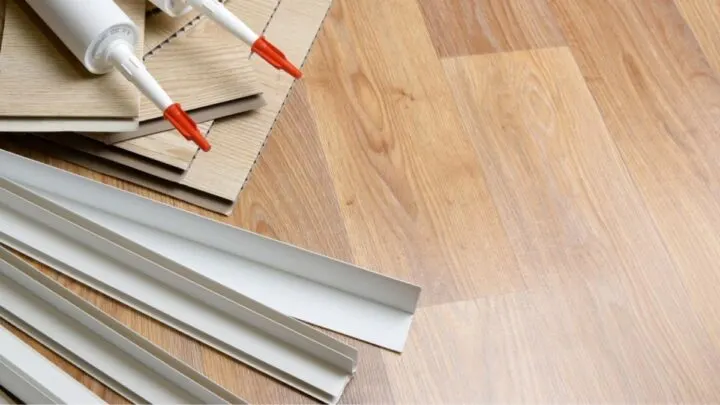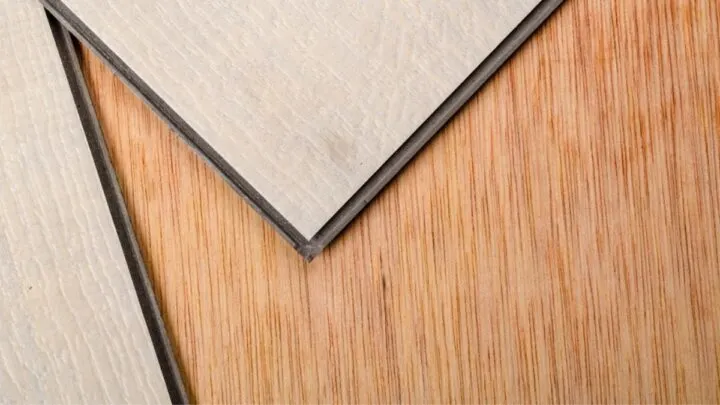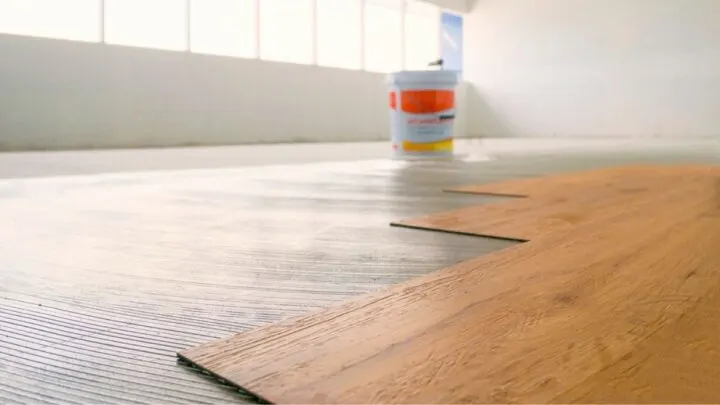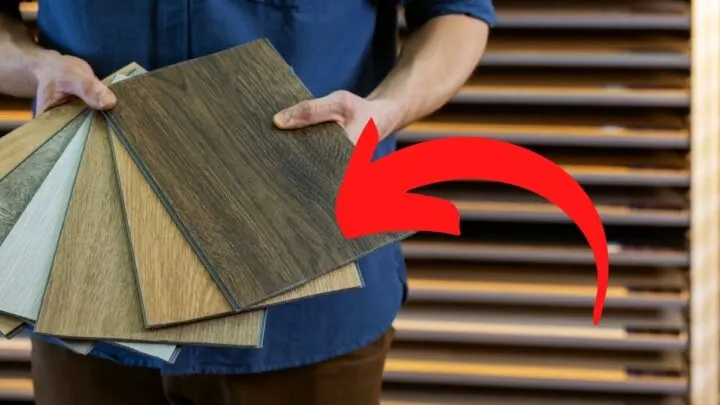Vinyl is an excellent flooring material, and it’s also quite versatile, but can you install it over tile, carpet, hardwood, or concrete?
Dealing with pre-existing flooring can be tricky, so many people prefer to lay a new material over the top of the old one to save themselves time and money.
However, you want to ensure that the new flooring material that you put in is suitable for this kind of installation.
You can install vinyl flooring over tile, carpet, hardwood, and concrete. However, you want to ensure that the previous flooring material is in good condition and does not have any major dips, cracks, splits, or uneven surfaces that will sabotage your vinyl flooring installation.
For so many homeowners, vinyl flooring is a go-to option. This is often one of the most affordable, versatile, and easy-to-use materials that you can lay your floor with.
However, one of the key features of vinyl flooring is its installation process.
Many materials require you to dismantle the pre-existing floor before you can begin installing the new one, which can be laborious, time-consuming, and costly, especially if you are dealing with contractors.
On the other hand, vinyl enables you to skip this step and lay down your floor on top of different materials without needing to do any dismantling.
With that being said, it is important that you properly gauge the condition of the pre-existing flooring before you commit to laying down your vinyl.
Although vinyl is a very versatile material, it does require that specific conditions be met for the installation to run smoothly.
To help you understand this further, we will take a closer look at the process of installing vinyl flooring over tile, carpet, hardwood, and concrete in more detail.

Can You Install Vinyl Flooring Over Tile?
If you have tiles in your home that need to be replaced, you are probably wondering if you can simply lay a new flooring material over the top of them.
You can install vinyl flooring over most tiles, provided that the surface is smooth and does not have too many seams or indentations.
More often than not, transitioning to vinyl flooring is particularly easy with ceramic and porcelain tiles but it can be done with stone tiles as well.
However, before you begin your installation, you want to confirm that your tile floor is going to be suitable for the vinyl.
Tile Height
The first thing that you want to check is that you have enough clearance between your tiles and objects in your house such as doors and cabinets.
A lot of floor installations are intended to leave just enough room between objects so that the design does not look tacky.
The last position you want to find yourself in after laying your vinyl over your tile flooring is that you cannot get out of your front door because you filled the gap and made it inaccessible.
If the gap is too tight, you will either need to remove the tiles beforehand or you can try sanding down the specific areas where doors and cabinets will have difficulty opening.
To get an idea of how much room you have, either lay a sample piece of the vinyl flooring down on the tile to see if there is any contact.
If you do not have the vinyl material handy, find out its exact thickness and measure the gap to confirm if it will fit.
Tile Condition
Vinyl flooring can look very sloppy if you lay the material over tiles that have any cracks, holes, or gaps.
Be thorough with this process, as it is often what leads to imperfections in a lot of flooring installations.
Ceramic and porcelain tiles generally have smooth surfaces to begin with. This makes them more reliable for vinyl floor installations.
Stone floor tiles, on the other hand, are not nearly as easy to deal with, as they tend to have gaps and uneven surfaces as part of their design.
Regardless, of what kind of tiles you have, you need to ensure that any cracks, uneven surfaces, or gaps are fixed before you begin laying down your vinyl flooring.
You can do this with a format board or a substrate, as this will get the surface flat and make it suitable for your vinyl flooring.
Can You Install Vinyl Flooring Over Carpet?
Carpet is a very common flooring material, and it can be a pain to remove. It weighs quite a lot and it is bulky, which makes it challenging to maneuver and requires a considerable amount of work to get rid of.
If you do not want to deal with your old carpet before installing your vinyl flooring, you are not the only one.
Luckily, there is a good chance that you can simply lay your vinyl flooring over your old carpet instead of having to remove it.
However, you need to ensure that your carpet is suitable for this kind of installation.
Carpet Type
This is going to be the most critical factor that will determine if you can lay vinyl flooring over your carpet.
This kind of installation works best with carpets that are not too thick and fluffy, as these can lead to complications with your vinyl floor.
Thick, soft carpets can impact the quality of your installation, and it can result in your vinyl getting damaged over time.
However, if you have got a firm and thin carpet, you should not have any issues laying down your vinyl flooring.
Carpet Level
You need to be working with a level surface when installing your vinyl flooring, and carpets are notorious for having indentations.
This is very common in areas where you have a lot of foot traffic, particularly in entryways and main walkways in your home.
Check these areas around your house to see if there are any soft spots where the carpet sinks in.
Do this for other parts of your home to confirm if there are any other anomalies that need to be treated.
You can generally remedy any indentations in your carpet by adding an underlayment to the floor before you start installing your vinyl.
Be sure to also measure the height of the carpet level to the rest of the objects in your home that you will need access to, such as your doors and cabinets.
There needs to be a big enough gap between the vinyl and the opening in order for the installation to be successful.
Carpet Quality
Carpets can get pretty gross after years of use. If you are installing vinyl flooring specifically to not deal with a nasty carpet, you may want to consider otherwise.
Your carpet does not need to be new by any means, but it should be in decent condition.
You do not want to install vinyl flooring over a carpet that has any mold underneath.
Check the quality of your carpet and confirm that its condition is solid before starting your installation.
Mold can cause respiratory problems and it will also end up damaging your vinyl floor, which will lower its life expectancy.

Can You Install Vinyl Flooring Over Hardwood?
The best flooring material to install vinyl over is hardwood.
The reason for this is that hardwood is often the most reliable for this kind of transition given its structure and dependability.
Hardwood floors that have been kept in good condition over the years can easily adapt to vinyl, and it is quite rare for there to be issues with this material compared to other flooring types.
However, you still want to ensure that the hardwood surface is going to be suitable for the transition by checking its condition.
Hardwood Quality
The quality of your hardwood is going to be the first thing that you want to assess before you start laying down your vinyl flooring. Much like with other flooring materials, your hardwood should be of decent quality.
This is rarely an issue with hardwood floors as they are quite resilient, but old hardwood floors have been known to deteriorate over time.
Suppose the hardwood in your home is very old or has experienced an issue such as flooding. In that case, you may want to consider removing the wood material before installing your vinyl flooring.
Unlike vinyl and other materials like tiles, hardwood can get damaged by water, which is one of the main reasons that its quality gets sabotaged.
Check for any signs of mold or other issues, as this can affect your vinyl floor installation.
With that being said, you may also want to reconsider laying down your vinyl flooring if you have a high-quality wooden material at home.
Vinyl will create permanent damage to your hardwood floors, which is not advisable if you have an expensive type of wood that can be refurbished.
Hardwood Condition
Regardless of the quality of your wood, you still want to take a look at the surface of your floor to assess its condition for any cracks, holes, or indentations.
Even if you have relatively new wooden floors, they can take a beating and get damaged quite easily, which will affect your vinyl installation.
If you see any anomalies, you must patch them up and fix them before you begin laying down the vinyl flooring.
You should also check to see if you have any major indentations where the hardwood floor sinks in. These are common in walkways and doorways where there is a lot of foot traffic.
If you see that your hardwood floor sinks in any of these areas, you will probably have to remove the entire plank over the spot and replace it with a new one before installing the vinyl.
Lastly, check to see that the height gap of the objects in your home is not going to interfere with the new flooring.

Can You Install Vinyl Flooring Over Concrete?
You can install vinyl flooring over concrete. This is generally a very easy installation, as a quality concrete surface is often the base layer of vinyl flooring.
This is a very common surface material in basements.
As always, even with concrete, the surface you are dealing with needs to be suitable for vinyl for the installation to succeed.
Concrete Condition
Concrete is a very hard material and it is known for being flat and smooth, which makes it ideal for vinyl and other types of flooring.
However, you still need to confirm that it is in good condition before you begin laying down your vinyl flooring.
It is quite common for a concrete slab not to get the same level of care and attention as other flooring materials when it is installed.
A concrete slab can easily have some imperfections when it is laid down, such as uneven surfaces and bumps.
These are going to affect the quality of your vinyl floor installation, and you will need to fix these beforehand.
With that being said, despite its hard surface, concrete can break and get damaged over time. A lot of concrete slabs will have cracks and holes.
We can commonly see this kind of damage in working areas – mostly in garages and basements.
Conduct a thorough inspection of the entire concrete slab before laying down any vinyl flooring so that you can spot any anomalies.
Luckily, fixing concrete damage is relatively straightforward, as all you essentially need for the job is more concrete.
Patch up any cracks, holes, and indentations so that you can install your vinyl smoothly onto the surface.
Summing Up Installing Vinyl Flooring
It’s generally very easy to install vinyl flooring over different types of material. As long as you make sure the tile, hardwood, carpet, or concrete flooring is prepped and ready beforehand, you should be all set to get started!
Make sure you consult a professional if you need to, but otherwise, happy remodeling!


